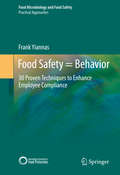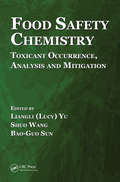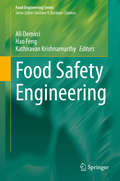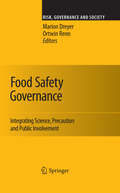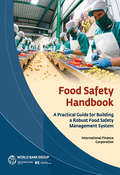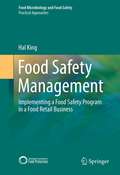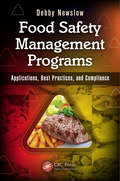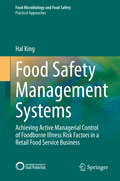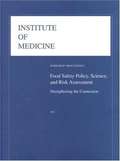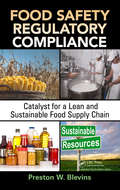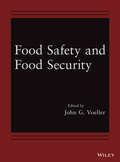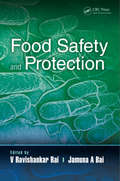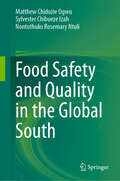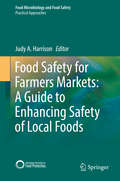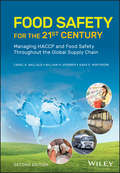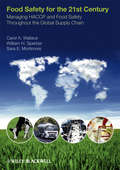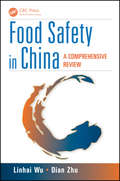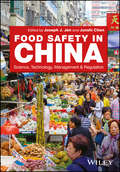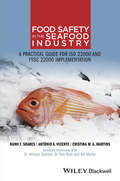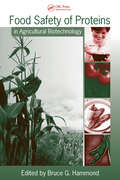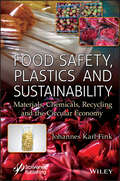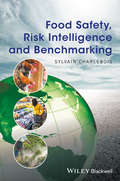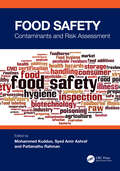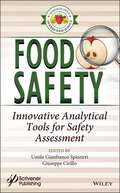- Table View
- List View
Food Safety = Behavior
by Frank YiannasThis book helps in Achieving food safety success which requires going beyond traditional training, testing, and inspectional approaches to managing risks. It requires a better understanding of the human dimensions of food safety. In the field of food safety today, much is documented about specific microbes, time/temperature processes, post-process contamination, and HACCP-things often called the hard sciences. There is not much published or discussed related to human behavior-often referred to as the "soft stuff. " However, looking at foodborne disease trends over the past few decades and published regulatory out-of-compliance rates of food safety risk factors, it's clear that the soft stuff is still the hard stuff. Despite the fact that thousands of employees have been trained in food safety around the world, millions have been spent globally on food safety research, and countless inspections and tests have been performed at home and abroad, food safety remains a significant public health challenge. Why is that? Because to improve food safety, we must realize that it's more than just food science; it's the behavioral sciences, too. In fact, simply put, food safety equals behavior. This is the fundamental principle of this book. If you are trying to improve the food safety performance of a retail or food service establishment, an organization with thousands of employees, or a local community, what you are really trying to do is change people's behavior. The ability to influence human behavior is well documented in the behavioral and social sciences. However, significant contributions to the scientific literature in the field of food safety are noticeably absent. This book will help advance the science by being the first significant collection of 50 proven behavioral science techniques, and be the first to show how these techniques can be applied to enhance employee compliance with desired food safety behaviors and make food safety the social norm in any organization.
Food Safety Chemistry: Toxicant Occurrence, Analysis and Mitigation
by Liangli Lucy Yu Shuo Wang Bao-Guo SunA comprehensive examination of the chemistry of food toxicants produced during processing, formulation, and storage of food, Food Safety Chemistry: Toxicant Occurrence, Analysis and Mitigation provides the information you need to develop practical approaches to control and reduce contaminant levels in food products and food ingredients, including c
Food Safety Engineering (Food Engineering Series)
by Hao Feng Ali Demirci Kathiravan KrishnamurthyFood Safety Engineering is the first reference work to provide up-to-date coverage of the advanced technologies and strategies for the engineering of safe foods. Researchers, laboratory staff and food industry professionals with an interest in food engineering safety will find a singular source containing all of the needed information required to understand this rapidly advancing topic. The text lays a solid foundation for solving microbial food safety problems, developing advanced thermal and non-thermal technologies, designing food safety preventive control processes and sustainable operation of the food safety preventive control processes. The first section of chapters presents a comprehensive overview of food microbiology from foodborne pathogens to detection methods. The next section focuses on preventative practices, detailing all of the major manufacturing processes assuring the safety of foods including Good Manufacturing Practices (GMP), Hazard Analysis and Critical Control Points (HACCP), Hazard Analysis and Risk-Based Preventive Controls (HARPC), food traceability, and recalls. Further sections provide insights into plant layout and equipment design, and maintenance. Modeling and process design are covered in depth. Conventional and novel preventive controls for food safety include the current and emerging food processing technologies. Further sections focus on such important aspects as aseptic packaging and post-packaging technologies. With its comprehensive scope of up-to-date technologies and manufacturing processes, this is a useful and first-of-its kind text for the next generation food safety engineering professionals.
Food Safety Governance
by Ortwin Renn Marion DreyerThis book offers a detailed analysis and a set of carefully measured suggestions towards achieving greater integration of science, precaution, and public involvement in current arrangements for European food safety governance. The devised governance framework provides a distinctive system of methodologies, participatory processes, and institutional configurations that demonstrates practical advice of how complex and conflicting food safety demands might be reconciled. At the core of the suggestions for procedural reform is a design with four governance stages (framing, assessment, evaluation, management, with participation and communication as cross-cutting activities), and an organisation into four assessment and management tracks distinguishing between risk-, precaution-, concern- and prevention-based approaches. In addition, the book suggests an innovative food safety interface structure designed to improve the politics-science-society coordination throughout the governance process.
Food Safety Handbook: A Practical Guide for Building a Robust Food Safety Management System
by International Finance CorporationThe Food Safety Handbook: A Practical Guide for Building a Robust Food Safety Management System, contains detailed information on food safety systems and what large and small food industry companies can do to establish, maintain, and enhance food safety in their operations. This new edition updates the guidelines and regulations since the previous 2016 edition, drawing on best practices and the knowledge IFC has gained in supporting food business operators around the world. The Food Safety Handbook is indispensable for all food business operators -- anywhere along the food production and processing value chain -- who want to develop a new food safety system or strengthen an existing one.
Food Safety Management
by Hal KingThe goal of this book is to show how to build and manage a food safety department that is tasked with ensuring food safety within a food retail business. The experiences of the author as the head of Food and Product Safety at Chick-fil-A will be used as the model. Specifically, the book will discuss the specific components of a food safety program, the tactics needed to establish these components (forming the majority of the chapters), how to measure the success of each component, and how to influence the organization to ensure resources to support the program. The book will also focus on how to choose and work with the appropriate partners, validate the value to the business, and initiate the new component throughout the organization, including how to sustain the component within the program. Five features of this book that make it distinctive are: - Most current "How to" book on leading a food safety department from the perspective of a respected national brand - Provides the proper organization and methods to manage the work necessary to ensure food safety within the organization - Provides the means to utilize risk-based decisions linked to business practices that accommodate a business analysis model - Demonstrates step-by-step examples that can be used for continuous improvement in sustaining food safety responsibilities - Provides examples on how to gain influence and obtain resources to support food safety responsibilities
Food Safety Management Programs: Applications, Best Practices, and Compliance
by Debby NewslowThe safety of food products is fundamental. The value of an effective and well-defined, -implemented, and -maintained management system is priceless. When it is integrated into a process, it supplies the necessary foundation and structure to help provide the consumer with a safe product of the highest quality. Food Safety Management Programs: Appli
Food Safety Management Systems: Achieving Active Managerial Control of Foodborne Illness Risk Factors in a Retail Food Service Business (Food Microbiology and Food Safety)
by Hal KingThis foodborne disease outbreak prevention manual is the first of its kind for the retail food service industry. Respected public health professional Hal King helps the reader understand, design, and implement a food safety management system that will achieve Active Managerial Control in all retail food service establishments, whether as part of a multi-restaurant chain or for multi-restaurant franchisees. According to the most recently published data by the Centers for Disease Control and Prevention (CDC), retail food service establishments are the most commonly reported locations (60%) leading to foodborne disease outbreaks in the United States every year. The Food and Drug Administration (FDA) has reported that in order to effectively reduce the major foodborne illness risk factors in retail food service, a food service business should use Food Safety Management Systems (FSMS); however less than 11% of audited food service businesses in a 2018 report were found using a well-documented FSMS. Clearly, there needs to be more focus on the prevention of foodborne disease illnesses and outbreaks in retail food service establishments. The purpose of this book is to help retail food service businesses implement FSMS to achieve Active Managerial Control (AMC) of foodborne illness risk factors. It is a key resource for retail professionals at all levels of the retail food service industry, and those leaders tasked to build and manage food safety departments within these organizations.
Food Safety Policy, Science, and Risk Assessment: Workshop Proceedings
by Food ForumThe National Academies Press (NAP)--publisher for the National Academies--publishes more than 200 books a year offering the most authoritative views, definitive information, and groundbreaking recommendations on a wide range of topics in science, engineering, and health. Our books are unique in that they are authored by the nation's leading experts in every scientific field.
Food Safety Regulatory Compliance: Catalyst for a Lean and Sustainable Food Supply Chain (ISSN #47)
by Preston W. BlevinsThe global sourcing of ingredients has created complex supply chains, significant management challenges, and additional regulatory compliance requirements. This places tremendous pressure on food manufacturers, many of whom lack the knowledge, concepts, techniques, and procedures to comply with these increased requirements. Providing a roadmap for
Food Safety and Food Security
by John G. VoellerFood Safety and Food Security features articles from the Wiley Handbook of Science and Technology for Homeland Security covering topics related to processing and packaging methods to protect food supply against contamination and to mitigate the consequences of contaminated foods. It discusses related detection systems as well as decontamination and disposal of contaminated foods.
Food Safety and Protection
by V Ravishankar Rai Jamuna A BaiThis book provides an overview of issues associated primarily with food safety, shelf-life assessment and preservation of foods. Food safety and protection is a multidisciplinary topic that focuses on the safety, quality, and security aspects of food. Food safety issues involve microbial risks in food products, foodborne infections, and intoxications and food allergenicity. Food protection deals with trends and risks associated with food packaging, advanced food packaging systems for enhancing product safety, the development and application of predictive models for food microbiology, food fraud prevention, and food laws and regulations with the aim to provide safe foods for consumers. Food Safety and Protection covers various aspects of food safety, security, and protection. It discusses the challenges involved in the prevention and control of foodborne illnesses due to microbial spoilage, contamination, and toxins. It starts with documentation on the microbiological and chemical hazards, including allergens, and extends to the advancements in food preservation and food packaging. The book covers new and safe food intervention techniques, predictive food microbiology, and modeling approaches. It reviews the legal framework, regulatory agencies, and laws and regulations for food protection. The book has five sections dealing with the topics of predictive microbiology for safe foods; food allergens, contaminants, and toxins; preservation of foods; food packaging; and food safety laws.
Food Safety and Quality in the Global South
by Sylvester Chibueze Izah Matthew Chidozie Ogwu Nontuthuko Rosemary NtuliThis book focuses on sustainable food systems in the Global South as highlighted by the United Nations Sustainable Development Goal 2, which seeks to end global hunger through food and nutrient security. It addresses the organoleptic properties of food that contribute to food quality as well as aspects of food safety such as the systematic handling, preparation, packaging, contamination, and storage within the food system to ensure food quality is maintained while preventing food-borne illnesses. The book assesses the state of food quality in the Global South and promotes the establishment of critical control points for food quality monitoring and maintaining adequate nutrient levels in food while keeping out organic, inorganic, and synthetic contaminants. The book also contains recommendations for corrective actions, including consumer information systems and remedial health actions. The book systematically connects food safety and quality in the Global South with broader health and sustainable development implications, including the rising concern of non-communicable diseases. This comprehensive book delves into various aspects of food safety and quality in the Global South, offering insights into challenges, solutions, and emerging trends across multiple disciplines. This book serves as a valuable resource for academics, researchers, policymakers, and practitioners involved in food science, public health, and sustainable development. The diverse range of topics covered contributes to a holistic understanding of the complexities involved in ensuring safe and high-quality food in the unique context of the Global South.
Food Safety and Quality-Based Shelf Life of Perishable Foods (Food Microbiology and Food Safety)
by Peter J. Taormina Margaret D. HardinThis book addresses the shelf life of foods, a key factor in determining how food is distributed and consequently where and when different food products are available for consumption. Shelf life is determined by several factors, including microbiological, chemical, physical, and organoleptic deterioration. Often these factors are interrelated and interdependent. The editors of this volume focus specifically on the microbial factors related to shelf life of perishable foods and food commodities. This allows for more detailed coverage of foodborne bacterial pathogens and spoilage microorganisms of concern. The initial part of the book covers the why and how of shelf life determination as well as the specific microbial pathogens and spoilage microorganisms of concern for perishable foods. Contributors address topics such as the techniques utilized for determination of shelf life, the frequency of shelf life testing for different products, the interpretation of data to make shelf life determinations, and management of shelf life of food products from the perspective of the food producer, distributor, retailer, and regulator. Three key areas impacting shelf life are addressed in detail: sanitation, processing, and packaging. The sanitation chapter explains the necessary components of cleaning and sanitizing to assure a hygienic processing environment and why that is critical to shelf life control. Traditional processing procedures are reviewed and advanced processing technologies are explored. Materials used in food packaging and the utilization of traditional and activated food packaging by product type are covered in detail. The latter two chapters of the book delve into newer techniques of analysis and explore the microbiome of food products. Implications of microbial ecology and microbial quantification in food products are discussed in chapters on genomics and in the changing dogma of meat shelf life. The primary audience for this work includes food industry quality and food safety technicians, managers, directors, and executives responsible for shelf life. Academicians and governmental researchers involved in research and teaching about food safety and quality will also find the material relevant and useful.
Food Safety for Farmers Markets: A Guide to Enhancing Safety of Local Foods
by Judy A. HarrisonThis book describes practices used on farms and in farmers markets selling foods directly to consumers in U. S. and international markets. It identifies hazards associated with those practices that could put consumers at increased risk for foodborne illness. It also provides tools for identifying hazards on farms and in markets and guidance for establishing food-safe markets. The local food movement, inspired by initiatives such as the USDA's "Know Your Farmer, Know Your Food"; "Farm to School"; "Farm to Pre-school"; and "The People's Garden", is sweeping the country. Nowhere is this interest more evident than at farmers markets. The number of farmers markets has increased almost 400% since the early 1990s, with over 8,600 farmers markets listed in the USDA's market directory in 2016. Many of the customers for local markets are senior adults, people who may have health concerns, and mothers with young children shopping for foods they perceive to be healthier and safer than those available in grocery stores. This means that many of the customers may be in population groups that are most at risk for foodborne illness and the serious complications that can result. In surveys, however, farmers selling directly to consumers self-reported practices that could increase risk for foodborne illnesses. These included use of raw manure as fertilizer without appropriate waiting periods between application and harvest, as outlined in the National Organic Program, a lack of sanitation training for farm workers handling produce, a lack of proper cleaning and sanitizing of surfaces that come in contact with produce, and use of untested surface water for rinsing produce before taking it to market. Surveys of market managers found that many had limited experience and most had no food safety plans for their markets. Observational studies in markets have corroborated self-reported practices that could increase foodborne illness risks, including lack of handwashing, lack of access to well-maintained toilet and handwashing facilities, use of materials that cannot be cleaned and sanitized appropriately, and lack of temperature control for foods that must have time and temperature controlled for safety. These potential food safety risks are not only seen in U. S. farmers markets, but also have been identified in international markets. This book is unique in that it provides evidence-based information about food safety hazards and potential risks associated with farmers markets. It presents an overview of farm and market practices and offers guidance for enhancing food safety on farms and in markets for educators, farmers, producers, vendors and market managers. Dr. Judy A. Harrison is a Professor in the Department of Foods and Nutrition at the University of Georgia (UGA) where she has been named a Walter Bernard Hill Fellow for distinguished achievement in public service and outreach. Serving as a food safety specialist for UGA Cooperative Extension, she has provided 25 years of food safety education for a variety of audiences across the food system.
Food Safety for the 21st Century: Managing HACCP and Food Safety Throughout the Global Supply Chain
by William H. Sperber Sara E. Mortimore Carol A. WallaceRevised to reflect the most recent developments in food safety, the second edition of Food Safety for the 21st Century offers practitioners an authoritative text that contains the essentials of food safety management in the global supply chain. The authors — noted experts in the field — reveal how to design, implement and maintain a stellar food safety programme. The book contains industry best-practices that can help businesses to improve their systems and accelerate the application of world-class food safety systems. The authors outline the key food safety considerations for individuals, businesses and organisations involved in today’s complex global food supply chains. The text contains the information needed to recognise food safety hazards, design safe products and processes and identify and manage effectively the necessary control mechanisms within the food business. The authors also include a detailed discussion of current issues and key challenges in the global food supply chain. This important guide: • Offers a thorough review of the various aspects of food safety and considers how to put in place an excellent food safety system• Contains the information on HACCP appropriate for all practitioners in the world-wide food supply chain• Assists new and existing business to meet their food safety goals and responsibilities• Includes illustrative examples of current thinking and challenges to food safety management and recommendations for making improvements to systems and practices Written for food safety managers, researchers and regulators worldwide, this revised guide offers a comprehensive text and an excellent reference for developing, implementing and maintaining world-class food safety programmes and shows how to protect and defend the food supply chain from threats.
Food Safety for the 21st Century: Managing HACCP and Food Safety Throughout the Global Supply Chain
by William H. Sperber Sara E. Mortimore Carol A. WallaceThe HACCP (Hazard Analysis and Critical Control Points) system is still recognised internationally as the most effective way to produce safe food throughout the supply chain, but a HACCP system cannot operate in a vacuum. It requires prerequisite programmes to be in place and it can be highly affected by, or dependent upon, other major considerations such as animal, plant, human and environmental health, food security and food defence. This book: Provides a practical and up-to-date text covering the essentials of food safety management in the global supply chain, giving the reader the knowledge and skills that they need to design, implement and maintain a world-class food safety programme. Builds on existing texts on HACCP and food safety, taking the next step forward in the evolution of HACCP and providing a text that is relevant to all sectors and sizes of food businesses throughout the world. Shares practical food safety experience, allowing development of best-practice approaches. This will allow existing businesses to improve their systems and enable businesses that are new to HACCP and food safety management requirements in both developed and developing countries to build on existing knowledge for more rapid application of world-class food safety systems. Educates practitioners such that they will be able to use their judgement in decision-making and to influence those who make food policy and manage food operations. This book is an essential resource for all scientists and managers in the food industry (manufacturing and foodservice); regulators and educators in the field of food safety; and students of food science and technology.
Food Safety in China: A Comprehensive Review
by Linhai Wu Dian ZhuChina is the world's top agricultural producer according to a World Trade Organization 2010 report, but a growing number of alarming safety issues has put the world's top manufacturer of food on the defensive. Food Safety in China: A Comprehensive Review chronicles China's current food safety problems from a professional perspective. This te
Food Safety in China: Science, Technology, Management and Regulation
by Joseph Jwu-Shan Jen Junshi ChenFrom contaminated infant formula to a spate of all-too familiar headlines in recent years, food safety has emerged as one of the harsher realities behind China's economic miracle. Tainted beef, horse meat and dioxin outbreaks in the western world have also put food safety in the global spotlight.Food Safety in China: Science, Technology, Management and Regulation presents a comprehensive overview of the history and current state of food safety in China, along with emerging regulatory trends and the likely future needs of the country. Although the focus is on China, global perspectives are presented in the chapters and 33 of the 99 authors are from outside of China.Timely and illuminating, this book offers invaluable insights into our understanding of a critical link in the increasingly globalized complex food supply chain of today's world.
Food Safety in the Seafood Industry
by António A. Vicente Cristina M. Martins Nuno F. SoaresSeafood is one of the most traded commodities worldwide. It is thus imperative that all companies and official control agencies ensure seafood safety and quality throughout the supply chain. Written in an accessible and succinct style, Food Safety in Seafood Industry: A practical guide for ISO 22000 and FSSC 22000 implementation brings together in one volume key information for those wanting to implement ISO 22000 or FSSC 22000 in the seafood manufacturing industry. Concise and highly practical, this book comprises: a presentation of seafood industry and its future perspectives the description of the main hazards associated to seafood (including an annexe featuring the analysis of notifications related with such hazards published by Rapid Alert System for Food and Feed - RASFF) interpretation of ISO 22000 clauses together with practical examples adapted to the seafood manufacturing industry the presentation of the most recent food safety scheme FSSC 22000 and the interpretation of the additional clauses that this scheme introduces when compared to ISO 22000 This practical guide is a valuable resource for seafood industry quality managers, food technologists, managers, consultants, professors and students. This book is a tool and a vehicle for further cooperation and information interchange around seafood safety and food safety systems. QR codes can be found throughout the book; when scanned they will allow the reader to contact the authors directly, know their personal views on each chapter and even access or request more details on the book content. We encourage the readers to use the QR codes or contact the editors via e-mail (foodsatefybooks@gmail.com) or Twitter (@foodsafetybooks) to make comments, suggestions or questions and to know how to access the Extended Book Content.
Food Safety of Proteins in Agricultural Biotechnology (ISSN)
by Bruce G. HammondWith contributions from internationally recognized experts, Food Safety of Proteins in Agricultural Biotechnology comprehensively addresses how toxicology testing of proteins should be accomplished and how protein safety assessments should be carried out. Beginning with a background on protein biology, the book delineates the fundamental difference
Food Safety, Plastics and Sustainability: Materials, Chemicals, Recycling and the Circular Economy
by Johannes Karl FinkFOOD SAFETY, PLASTICS AND SUSTAINABILITY A unique book by a well-known polymer scientist on a subject that is trending in plastics engineering. This book focuses on plastics for food safety, materials, chemicals and methods, as well as the applications of these polymers. The book begins with a chapter on food safety. Here, food security and the issues of migration of substances from packaging into the corresponding food, as well as the impact of microplastics on humans and the environment are discussed. In the next chapter, regulations, standards, and specifications are detailed. In another chapter, testing methods, such as risk assessment, freshness testing of food, and food colorants are discussed. In the chapter entitled “Food Packaging”, the methods that can be used for these issues are given as well as the special materials for food packaging. The chapter on materials includes a discussion on nanocomposites, biopolymers, microplastics, and edible films. This is followed by chapters on additives and applications, such as functional food applications. The final chapter covers the identification of the materials, the methods for recycling, plastic waste generation, and post-consumer polyolefins. Three separate indexes ensure a reader/user-friendly experience.
Food Safety, Risk Intelligence and Benchmarking
by Sylvain CharleboisThis book comprehensively argues for more future benchmarking between nations. Since the initial food safety benchmarking report was published in 2008, the sharing of data and protocols among nations has dramatically increased. It was intended to identify and evaluate common elements among global food safety systems. More specifically, benchmarking identifies those countries that employ comparatively best practices to assess, manage, and communicate the risks related to the safety of food and their respective food systems. The overarching intent of this benchmarking assessment, however, is to stimulate exchange and discussion on food safety performance among nations.
Food Safety: Contaminants and Risk Assessment
by Mohammed Kuddus Syed Amir Ashraf Pattanathu RahmanFood Safety: Contaminants and Risk Assessment is a state-of-art reference on food safety, which is the biggest challenge in the food supply chains worldwide. Despite advancements in hygiene, food treatment, and food processing, foodborne pathogens or food contaminants still represent a significant threat to human health. This book presents comprehensive information about the major food contaminants across food types. The text provides facts about setting up food safety initiatives and safety rules, foodborne pathogen detection, production and processing compliance issues, and safety education.Key Features Examines a diverse range of contaminants across food types Describes various food allergens and allergies Discusses contamination in drinking water and bottled water Reviews the international regulations for management of food hazards Throws light on the overall impact of food safety of global food supply chains This book is meant for postgraduate students, researchers, and food industry professionals.
Food Safety: Innovative Analytical Tools for Safety Assessment
by Umile Gianfranco Spizzirri Giuseppe CrilloFood safety and quality are key objectives for food scientists and industries all over the world. To achieve this goal, several analytical techniques (based on both destructive detection and nondestructive detection) have been proposed to fit the government regulations. The book aims to cover all the analytical aspects of the food quality and safety assessment. For this purpose, the volume describes the most relevant techniques employed for the determination of the major food components (e.g. protein, polysaccharides, lipds, vitamins, etc.), with peculiar attention to the recent development in the field. Furthermore, the evaluation of the risk associated with food consumption is performed by exploring the recent advances in the detection of the key food contaminants (e.g. biogenic amines, pesticides, toxins, etc.). Chapters tackle such subject as: GMO Analysis Methods in Food Current Analytical Techniques for the Analysis of Food Lipids Analytical Methods for the Analysis of Sweeteners in Food Analytical Methods for Pesticides Detection in Foodstuffs Food and Viral Contamination Application of Biosensors to Food Analysis
